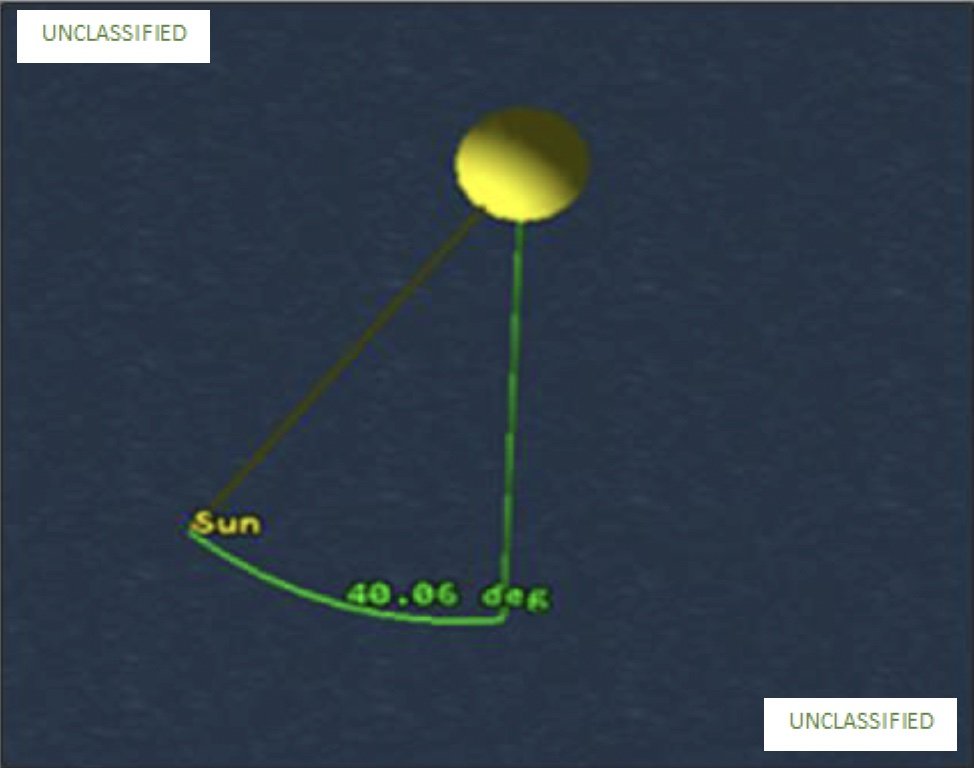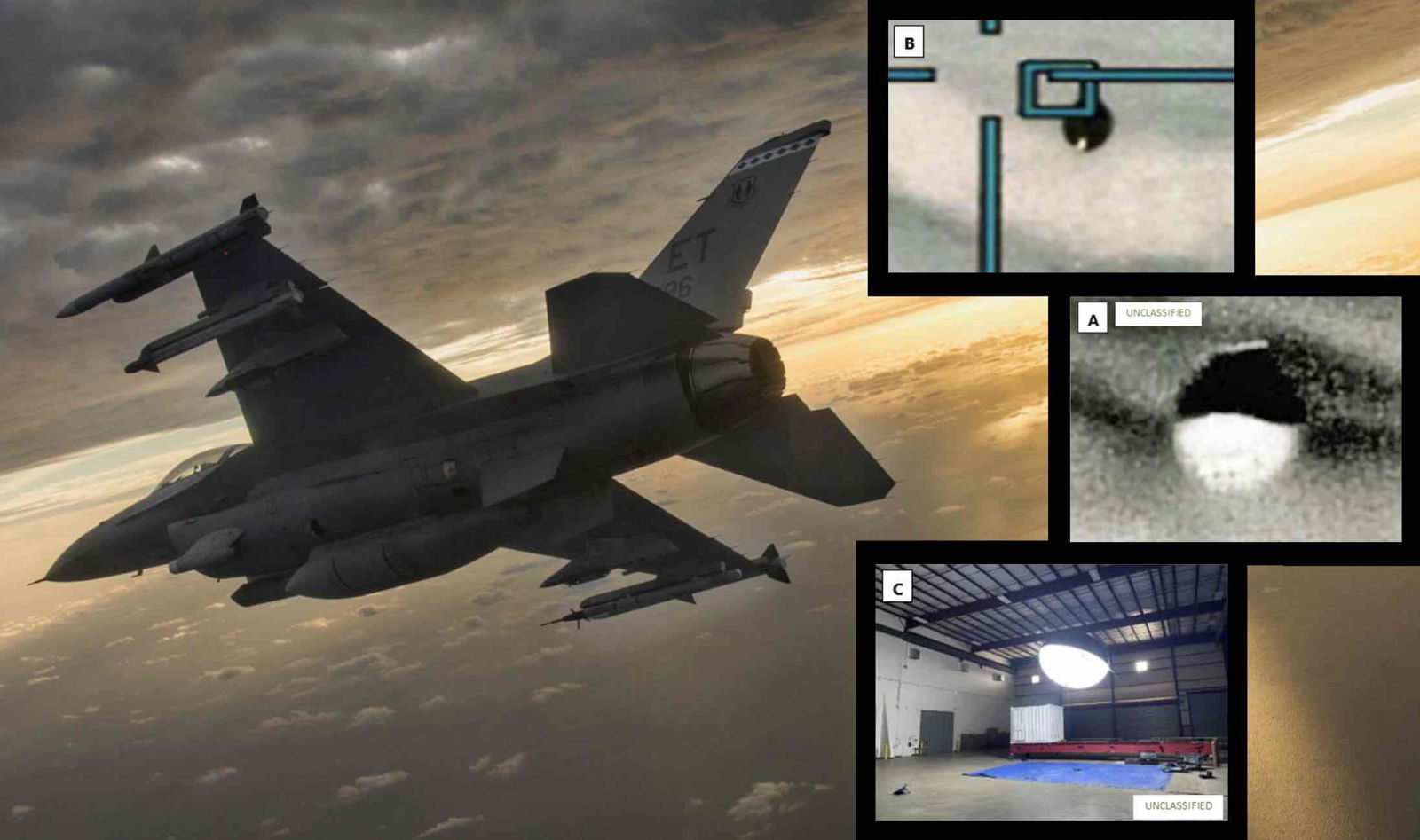In January 2023, a military pilot reportedly encountered a series of unidentified objects while participating in training exercises over the Gulf of Mexico near Eglin Air Force Base, Florida.
Initially detected on radar, the four objects appeared to maintain a diamond-shaped formation, and the pilot was able to obtain images of the nearest of them using electro-optical and infrared imaging systems on his aircraft, despite various system malfunctions that occurred as he closed to within 4,000 feet of the unidentified craft. In shape and appearance, the pilot likened the mysterious object to an Apollo-era spacecraft.
The incident, initially revealed publicly by Florida Representative Matt Gaetz during a hearing by the Subcommittee on National Security, the Border, and Foreign Affairs last summer, became the subject of a Freedom of Information Act request that revealed a drawing of the object made by the pilot, but offered few additional details.
That remained the case until last month, when an official report by the Pentagon’s All-domain Anomaly Resolution Office (AARO) was released that revealed images of the object photographed by the military pilot for the first time. According to its report, AARO’s team labeled the case “Resolved” after the official government office tasked with the investigation of unidentified anomalous phenomena—objects traditionally known as UFOs—concluded that the craft in the images had likely been some kind of lighter-than-air object. In other words, it was most probable that the object was a balloon.
Yet from the outset, there were problems with AARO’s analysis, whose investigators asserted only “moderate confidence” in their findings. The sparing report, while making no attempt to account for the other three objects initially observed on radar, likened the sole object photographed by the pilot to “a commercial lighting balloon,” even though images of the object obtained during the incident essentially matched the pilot’s description of an “Apollo spacecraft” with a rounded under portion and conical top.
The problems with AARO’s analysis weren’t overlooked by Mick West, arguably the most well-known UFO skeptic and the administrator of Metabunk, a website that crowdsources information West and other site contributors use to attempt to resolve UAP cases. In a posting on X following the release of AARO’s case analysis on the Eglin incident, West was quick to point out that the object in the photos obtained by the pilot bore little resemblance to images of a commercial lighting balloon used for comparison in AARO’s report.
“This Eglin UFO looks like a white sphere wearing a hat,” West wrote in his X posting that accompanied an image comparison he produced. “It shows a quite irregular ‘hat,’ which is not really consistent with the lighting balloon hypothesis.”
This Eglin UFO looks like a white sphere wearing a hat.
The image on the left is the IR thermal image, adjusted the levels only. It shows a quite irregular “hat,” which is not really consistent with the lighting balloon hypothesis. pic.twitter.com/BuPRSRJ2BS
— Mick West (@MickWest) April 25, 2024
Continuing the dialogue in a thread on the Metabunk forum, West noted on April 24, 2023, that some of AARO’s analysis still “seems a bit of a stretch.” For instance, in one portion of AARO’s analysis of the Eglin incident, the report’s authors note that “It is also plausible that the sun angle at the time of day of the event, when plotted with the EO/IR sensor’s viewing angle, illuminated the bottom half of the balloon— from the pilot’s perspective—while the top would appear dark, shaded, and cold.”
“I have never heard of ‘Earth Shine’ outside of the context of the Moon at night (or during a total eclipse),” West wrote in his posting at Metabunk. “But then the IC partner seems to think it’s direct illumination.”
“Their diagram is of little help,” West noted further, referring to an illustration in AARO’s report, which its authors use to explain why the lower portion of the object photographed by the pilot during the January 2023 incident might have appeared brighter than its upper portion, which West noted seems to be “at odds with the ‘earth shine’ theory.”


The Debrief reached out to West regarding his views on AARO’s analysis of the Eglin UAP case, as well as other issues that have arisen with official publications issued by the Pentagon’s UAP investigative office in recent weeks; most notably, AARO’s long-awaited “Report on the Historical Record of U.S. Government Involvement with Unidentified Anomalous Phenomena (UAP) Volume I,” which it released earlier this year.


For West, the lighting balloon theory falls short of offering a definitive resolution for the case, as do several of AARO’s other recent assertions.
“The lighting balloon hypothesis always felt like something someone at AARO liked, but wasn’t really supported by much evidence,” West told The Debrief in an email.
In an interview earlier this year with Peter Bergen on his “In the Room with Peter Bergen” podcast, Dr. Sean Kirkpatrick, the former director of the Pentagon’s All-domain Anomaly Resolution Office, made vague references to instances where ‘Tic-Tac’-shaped balloons produced by a Florida-based company were believed to have escaped.
“One of my favorite things is there’s this company in Florida,” Kirkpatrick told Bergen during the interview. “They make these backyard lighting balloons. Some of them are round. Some of them are tic tac shaped, and they’re black on the top, and inside, they have lights, and they’re helium filled. And they’re strapped down in people’s backyards for backyard parties, and they get away. When we talked to the company, they’re like, ‘yeah, we lose ’em. And we sometimes find them again, but generally not.”


“Well, you know, that’s a really weird-looking thing. Lit from the bottom, not light on the top, big tic-tac thing, flying around. Well, what is that? That kind of stuff is a flight hazard,” Kirkpatrick told Bergen at the time, although offering no additional details on any instances where such an object was believed to have been mistaken for a UAP.
West told The Debrief that Kirkpatrick’s remarks had initially sounded “almost as if he was trying to explain the Nimitz Tic-Tac, which would be rather a stretch.” However, with the release of the AARO’s report on the Eglin UAP case, it is now clear that this was the incident Kirkpatrick had been referring to at the time. West says that although some kind of lighter-than-air object cannot be dismissed, even AARO seemed uncertain whether this was a definitive conclusion, despite the report now being categorized as resolved.
“In the Eglin case, it can’t be ruled out, but it’s also not the only hypothesis [AARO] put forward,” West points out, noting that AARO’s recent report on the incident suggests that the Eglin UAP had been “very likely a lighter-than-air object, such as a large commercial lighting balloon,” although the report’s authors express that limited data on the case makes it difficult to rule out other potential explanations.
One of the primary issues critics have raised with the balloon hypothesis is that while it could potentially explain a single object, such as the one photographed by the military pilot during the January 2023 incident, this theory becomes more difficult when attempting to apply it to all four objects initially observed on radar.
Although West concedes this point, he also notes that AARO’s report never claimed that the lighting balloon hypothesis could account for all the objects, which the pilot initially judged to have been holding a diamond-shaped formation and potentially remaining stationary amidst 80 mph winds. If anything, AARO’s investigators seemingly ignored the presence of the additional three objects detected on radar, apart from a brief mention of them near the outset of their report.
West says that while the release of radar data from the Eglin incident might be helpful in making further determinations about the other objects the pilot detected, some caution would still be warranted.
“There’s a long history of conflating radar data with visual sightings,” West told The Debrief. “Unless it can clearly be demonstrated, we need to be open to the idea that what was seen on radar was not the same thing as seen visually (or on other sensors).” West cites similar instances where radar returns may have been unrelated to the primary objects captured on camera, including a case investigated by the Chilean Navy several years ago, which, after initially being touted as an unknown, was quickly revealed to have been a conventional aircraft.
“In the Chilean Navy case, much was made of the fact that there was no object on radar where the pilots thought the object was,” West says, “because it was 3x as far away.”
“So [the Eglin] the radar data could be something else, an unrelated glitch, or maybe even something related to the object (like a radar jammer/spoofer).”
While these possibilities exist, fundamentally, it remains unknown what the radar data might actually entail since, in addition to very little being said about it in AARO’s report, it presently remains inaccessible to the public.
“The problem here is that we don’t have the data,” West says. “We have the assessments of multiple experts that the sum total of the available data points towards something non-anomalous and lighter than air.”
“But unfortunately, we can’t check their work.”
Asked if he felt that it would be helpful for independent analysts to review at least some of the additional data that was available to AARO investigators, West said that this might not only make AARO’s job easier, but it could potentially improve their analysis in significant ways.
“Ideally the data would be public, as the more eyes you have on something, the quicker issues and questions get resolved,” West told The Debrief. “AARO works with two partners, an IC (Intelligence Community) partner and an S&T (Science and Technology) partner. It’s not clear who they are, but they both seem to have reached similar conclusions. Oddly, neither seem to comment on the lighting balloon hypothesis, which suggests that it was internal to AARO, so three teams.”
One primary issue is that AARO, by virtue of its job within the government, often has to work with classified information related to various technologies and military operations. This limits its ability to properly communicate its findings and how much it can reveal about the experts and kinds of analysis from these three teams being employed in AARO’s investigations.
“The multi-domain and classified approach results in a fragmented report with very little visibility as to the workings of the three teams,” West says. “Adding more people, such as myself, or the broader public, would help iron out the inconsistencies and poorly communicated details.”
“There’s a risk it gets too messy, but I advocate for an approach called ‘curated crowdsourcing,’ which I described a few years ago,” West says, referencing an article in which he explains how crowdsourced information and analysis led to a reasonable explanation for the Chilean UAP footage within just a few days of its release.
Had the issues present in its recent report on the Eglin incident been the only instance where problems in AARO’s conclusions had been noted, some of the problems with its analysis might have been deemed innocuous. However, the release of the office’s proposed resolution for the 2023 Eglin UAP incident follows just weeks after the appearance of AARO’s Historical Record Report Volume I, which received a lackluster reception due to several factual inaccuracies it contained.
West shares some of those concerns about the mistakes in AARO’s recent publications, which he feels point to why independent analysis by civilian researchers is important.
“AARO should have had the report fact-checked and edited,” West told The Debrief. “They messed up.”
“They have multiple teams of highly paid people working with them, and they have done some good work. But putting out a report with lots of minor errors makes them look bad and casts doubt on their broader conclusions, such as the circular conversations leading up to the Kona Blue proposal and stories about crash retrievals.”
Unlike cases such as the Eglin UAP incident, which may involve reliance on some appropriately classified information, the public version of AARO’s historical report draws much of its contents from publicly accessible information. Additionally, an unclassified version of the report was planned for public release all along, as directed in legislation passed into law that required the completion and publication of the report.
Given that it was destined for public release anyhow, West told The Debrief that AARO might have benefited from having independent researchers offer feedback before the final version of the Historical Report was published.
“Since the report was going to be unclassified, there’s no reason why they could not utilize outside experts to review an embargoed version,” West says. “They could even contract with them, having them sign NDAs.
Fundamentally, West says that working more closely with independent researchers under such circumstances could have helped AARO produce a better, more accurate final report and may have reduced negative responses from many who, justifiably, viewed the report as lacking quality and factual merit.
“There’s no real downside,” West concluded, “and an error-free report is a much better way of conveying your research and conclusions than what they actually produced.”
Micah Hanks is the Editor-in-Chief and Co-Founder of The Debrief. He can be reached by email at micah@thedebrief.org. Follow his work at micahhanks.com and on X: @MicahHanks.

